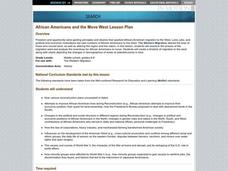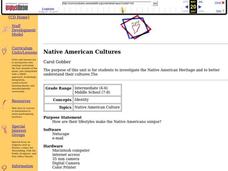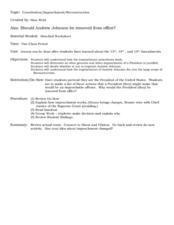Curated OER
Revolutionary Women of South Carolina
Students examine multiple primary sources. In this revolutionary war lesson, students read case studies regarding women from South Carolina. Students will compare the different roles women played during the Revolutionary War. Students...
Curated OER
American Culture in a Musical Setting
Students discover the significance of similarities and contrasts of three separate cultures of the United States through music. They take out maps and trace the expedition of the Spanish along the coasts of Mexico and North and South...
Curated OER
War Time Propaganda: American Posters of the Great War
Students identify propaganda related to World War and discuss its impact on society and research issues related to the American war effort between 1914 and 1918.
Curated OER
School Desegregation in South Carolina
Eleventh graders interpret historical evidence presented in primary and secondary resources. In this North Carolina history instructional activity, 11th graders examine the Briggs v. Elliott case in order to understand the difference in...
Curated OER
In the Shadow of My Country: A Japanese American Artist Remembers
Students analyze artist's themes and means of communication, think critically about their sources of information, and weigh claims of national security against the civil liberties of diverse groups.
Curated OER
South Dakota
In this South Dakota worksheet, students read 9 short paragraphs about the early settlement and statehood of South Dakota. Worksheet has no other associated activities.
Curated OER
What was life like for African Americans after the Reconstruction?
Students examine the origins and effects of Jim Crow laws and how specific legislation supported segregation. The lesson provides foundational, historical background for unit on the media's role in the social justice campaign of the...
Curated OER
Municipal Government in South Carolina
Twelfth graders complete several activities as they study and explore the three different types of municipal governments allowed in South Carolina and the types of services provided for people within these metropolitan areas.
Curated OER
African Americans and the Move West
Middle schoolers examine the phases of westward migration in the United States during the 19th century focusing on the incentives that led many African Americans to make the move.
Curated OER
New Perspectives On Teaching Afro-American History
Students examine the Great Migration of African Americans to the North from the South. After reading a primary source document, they respond to the letter given a set of questions. In groups, they research the funding for white and...
Curated OER
South Carolina's Constitution
Eighth graders explore the definition of political culture. After viewing a movie, 8th graders discuss how the political culture of the 1600 and 1700s is reflected in early drafts of the South Carolina constitution.
Curated OER
Voluntary Movement or Not? Africian-American Movement to the West
Ninth graders, in groups, determine reasons for African-American migration to the west
Curated OER
African Americans: 1800 - 1870
Students explore living and working environment of both slave and free African Americans from places throughout the United States.
Curated OER
Native American Cultures
Students investigate the Native American Heritage and explore their customs cultures. They discover characteristics of the Native Americans through the study of their art, artifacts, stories and symbols.
Curated OER
Checks and Balances: Japanese-American Incarceration
Middle schoolers examine the three branches of the Federal Government and their decision to place Japanese-Americans in camps during World War II. They analyze debates made by leaders during this time period.
Curated OER
American Indian Cooking Before 1500
Students read and discuss an article about Native American cooking practices before 1500. In small groups they recreate a recipe for pemmican and sample the results. They discuss how food preparation and ingredients differ from modern...
Curated OER
The Great Migration: Pushed By The South, Pulled By The North
Learners identify key features of the Great Migration. They explain the concepts of push and pull factors for migration. They create an art project which shows an understanding of the push and pull factors.
Curated OER
Chalkboard Challenge: Social Studies Online
If used as an independent review, this presentation could be a quick way for students to study U.S. History facts. Since it only presents a few simple facts, it would not be adequate for a comprehensive review, but a teacher could...
Alabama Department of Archives and History
Yellow Journalism
What role did yellow journalism play in bringing the United States into war with Spain? As part of their study of the Spanish-American War, class groups examine newspapers of the times and other texts and then produce their own...
Civil War Trust
The Gathering Storm: The Coming of the Civil War
Take a longer look at a formative time in history with a lesson that explores the causes of the American Civil War. After viewing a series of images and explanations for various forces at play, middle schoolers choose the images that...
Curated OER
Constitution/Impeachment/Reconstruction
Eleventh graders analyze a chart comparing U.S. census data from 1850, 1880, 1900, and 1920. They read a handout summarizing immigration legislation from 1882-1996 and create a graph charting how open / closed U.S. immigration is over time.
Council for Economic Education
Economic Systems of the Incas and Aztecs
The Inca and Aztecs created vast economic empires in South America, but how did economics play a role? A simulation activity and reading help scholars evaluate the kinds of markets these great civilizations created. They then consider...
Digital Public Library of America
Teaching Guide: Exploring To Kill a Mockingbird
Harper Lee's To Kill a Mockingbird, considered by many to be a seminal piece of American literature, contains many complex literary themes that carry through United States history. Use a series of discussion questions and classroom...
New York City Department of Education
Geography and Early Peoples of the Western Hemisphere
Young historians discover the early people of the western hemisphere. The unit explores how the land changed, how it was used and homes of early Americans such as Incas, Mayans, Inuits, Aztecs, and Pueblos. Individuals also examine these...

























